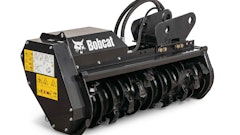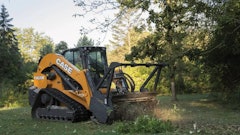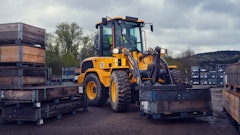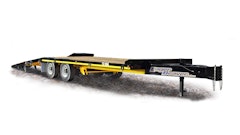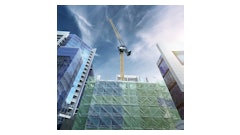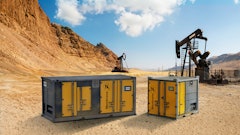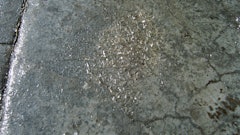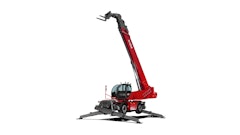
Information from this article was first published in Demolition Magazine and is being reused with permission from the National Demolition Association.
Founded in 1867, The United States Playing Card Company has led the world in the design and manufacturing of quality playing cards. This project, located just outside Cincinnati in Norwood, Ohio, entailed the remediation and demolition of the plant that served as its world headquarters from 1899 until 2009. The facility was designed by Samuel Hannaford and Sons, who also designed the iconic Cincinnati Music Hall and Cincinnati City Hall. The historic clock tower is on the National Register of Historic Places and was preserved by National Demolition Association (NDA) member O’Rourke Wrecking Company for incorporation into the new site redevelopment. The United States Playing Card Company (USPC) continues to manufacture many iconic brands of playing cards including Bicycle, BEE, Aviator, Aristocrat and many more.
 United States Playing Card Company headquarters
United States Playing Card Company headquarters
In 2009, the aging facility was finally abandoned as production transitioned to a modern factory. Many uses of the site were explored over the next decade. In 2019, the site was acquired by a developer with ambitious plans to invest $100 million into the 21-acre site to convert it to a mixed-use development.
The developer relied on upon O’Rourke’s 58-year repository of vast demolition and abatement experience to devise and implement a site-specific environmental/demolition/site safety plan that was unique to the challenge of abating and demolishing multiple buildings, with integral buildings/structures that had to segregated and protected under a fast paced schedule.
O’Rourke was engaged to study the environmental and demolition challenges to achieve the best use of the property while respecting the historic aspects of the site. The facility’s construction began in 1899 and continued into the 1920s. The result was a group of interconnected structures primarily of wood post and beam construction, while the newest buildings were constructed of reinforced concrete. Steam for heat was supplied by the boiler house on-site through a system of below-grade steam tunnels.
The historic clock tower and smokestack that served the boiler house were protected and preserved for reincorporation into the redevelopment effort.
As the project kickoff neared, the start of work was delayed. Hollywood came calling! Because the site was so unique, the developer allowed a Bruce Willis movie tentatively titled “Open Source” to film there. Part of the agreement included that the historic clock tower had to be captured on film. (Editor's Note: The movie was released in August 2020 under the title "Hard Kill".)
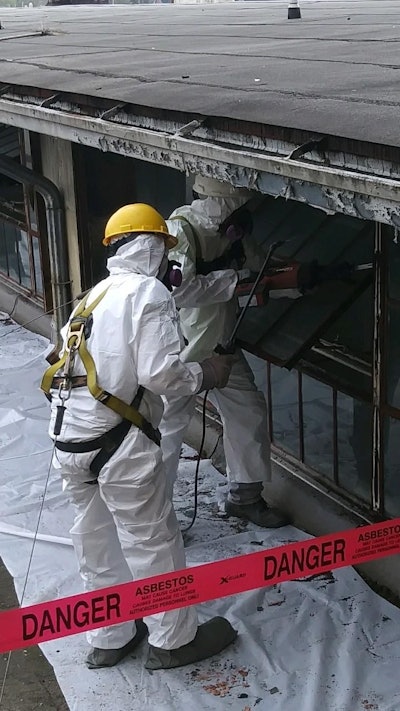 Asbestos abatement
Asbestos abatement
O’Rourke crews began work in March 2020 with a team of 20 trained asbestos workers to abate the large amount of RACM on-site. The largest area of concern was the boiler house that had two coal-fired brick boilers and a labyrinth of below-grade steam tunnels that contained thousands of feet of ACM piping.
Once asbestos abatement progressed, a phased utility shutdown of the site began. This was critical, as most of the buildings were of wood construction, and fire safety was a key concern. O’Rourke relied on its extensive fleet of equipment to accomplish the project. A Link Belt LS 208 Crane, five CAT Excavators with shears and grapples, and a fleet of trucks were utilized for scrap/debris removal.
Keys to successful demolition
Successful demolition work at the former U.S. Playing Card Facility involved a combination of conventional mass demolition, specialized dismantling/deconstruction, rigging, torch-cutting, debris segregation and load-out activities carefully orchestrated and implemented by trained demolition personnel. A proactive approach was utilized included controlled demolition techniques, well thought-out building/infrastructure protection, and demolition personnel protection measures was used to successfully perform the demolition work. The goal of 100% debris containment within the active demolition work zone was achieved.
Prior to the start of active demolition: installation of supplemental temporary fence panels; establishing general site security and access procedures; and protocol and verification of utility disconnects and make safe. Incidental work included preparation of appropriate project pre-planning documents; obtaining necessary demolition permits and filing notifications; removal of demolition debris from the site; tracking of waste streams; submittal of close-out documentation; and other associated demolition-specific support activities.
For the ultra-selective demolition work to separate the clock tower, two crews of four men worked to hand-demolish and isolate all buildings surrounding the clock tower in a floor-by-floor manner. Care was taken to segregate and recycle as much timber and floor planking as possible throughout the process. Over 250,000 BF of timbers were salvaged from the structures. Also, the common brick from the facility was very desirable. Approximately 750,000 brick were cleaned and palletized for reuse.
This project clearly demonstrated demolition as a green industry by recycling 90% of debris and clearing a degrading/dilapidated plant while maintaining its history in preparation for new construction of a much needed development in Norwood. At O’Rourke, we believe that there will be a tomorrow, and our core business practices reflect this concern for the future. Our corporate sustainability goal is to reduce, recycle and repurpose/reuse materials whenever possible on all of our projects.
Waste generation, segregation, sampling/profiling, manifesting, transportation and disposal/recycling were monitored daily to assure compliance with and adherence to all applicable federal, state and local regulations. A Waste Tracking Log was kept documenting all debris leaving the site and made available during performance of work.
By implementing a site-specific demolition strategy that focused on protection of adjacent properties/businesses, the general public and the surrounding environment made it successful for both O’Rourke and, importantly, the owner. Our multilayered demolition approach and top-notch crews delivered the site in a safe, efficient, and timely manner and clearly exceeded industry standard practices and requirements. Work is scheduled to complete on time at the end of September 2020.
Project statistics
- Length of project: 7 months
- Timber salvaged: Over 250,000 BF
- Bricks cleaned for reuse: 750,000
- Concrete recycled and crushed: 20,000 CY
Equipment used
- Link Belt SL 208 Crane with clam bucket and wrecking ball
- Five CAT Excavators with shears and grapples
- Two Bobcats
- Two man lifts
- 10 trucks per day
Historical significance
History made at the Norwood plant extends well beyond its famous clock tower. Interestingly, the plant played an important role in some of our nation’s conflicts. During WWII, in collaboration with the U.S. government, USPC developed “spotter” decks that featured illustrations of tanks, ships and aircraft used by enemy forces to aid military personnel in identifying the enemy.
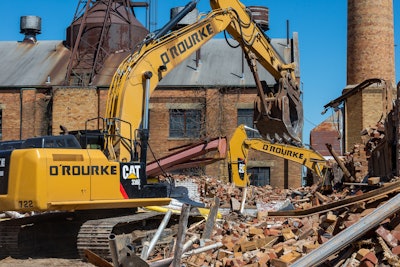 Part of the demolition equipment lineup included five Caterpillar excavators with shears and grapples.
Part of the demolition equipment lineup included five Caterpillar excavators with shears and grapples.
Very little is known about the clandestine decks, as they were kept secret after the war because their use was a violation of the Geneva Convention. The only two surviving decks are currently housed in the International Spy Museum in Washington, D.C.
During the Vietnam War, USPC produced decks of cards that contained only the ace of spades. These special decks were used as psychological warfare, as the Vietcong were very superstitious and frightened of this ace. They believed it predicted death and suffering. Thousands of the decks were sent to the U.S. troops in Vietnam, and the cards were deliberately scattered in the jungle and in hostile villages during raids.
Michael P. O’Rourke is the president of O’Rourke Wrecking Company.




